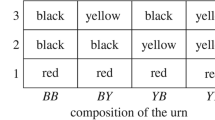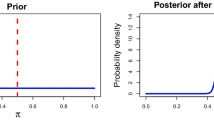Abstract
It is well known that classical, aka ‘sharp’, Bayesian decision theory, which models belief states as single probability functions, faces a number of serious difficulties with respect to its handling of agnosticism. These difficulties have led to the increasing popularity of so-called ‘imprecise’ models of decision-making, which represent belief states as sets of probability functions. In a recent paper, however, Adam Elga has argued in favour of a putative normative principle of sequential choice that he claims to be borne out by the sharp model but not by any promising incarnation of its imprecise counterpart. After first pointing out that Elga has fallen short of establishing that his principle is indeed uniquely borne out by the sharp model, I cast aspersions on its plausibility. I show that a slight weakening of the principle is satisfied by at least one, but interestingly not all, varieties of the imprecise model and point out that Elga has failed to motivate his stronger commitment.


Similar content being viewed by others
Notes
I shall briefly review some of these difficulties later on in the paper, for those readers who may not be familiar with them.
More precisely: for all \(Q\in\wp(W)\), if Q the strongest proposition learnt by S between t and t + 1, then for all \(P\in\wp(W),\; \hbox{Pr}_{t+1}(P)\) is set equal to \(\hbox{Pr}_{t}(P\mid Q)\).
\(\hbox{E}_{{\rm Pr}_{t}}(\hbox{U}_{t}\mid P)\) is given by \(\left[\Upsigma_{w\in P}\hbox{U}_{t}(w)\hbox{Pr}_{t}(\{w\})\right]/\hbox{Pr}(P)\), on the assumption that W is countable.
In other words, where \({\mathbb{A}}\) denotes a partition of W and \({A\in\mathbb{A}}\), C t satisfies:
$${\textsc{Max}}\,\hbox{EU}\!\!:\,{A\in{\rm C}_t(\mathbb{A})}\,\text{iff for all}\,{B\in\mathbb{A}},\hbox{E}_{{\rm Pr}_{t}}(\hbox{U}_{t}\mid A)\geq \hbox{E}_{{\rm Pr}_{t}}(\hbox{U}_{t}\mid B)$$See Machina (1987) for an influential overview.
See Camerer and Weber (1992) for a survey of some of the experimental data.
Note however that this popular suggestion has attracted a certain degree of controversy, since it countenances a phenomenon known as ‘probabilistic dilation’, which some, such as White (2010), have judged to be counterintuitive. See Joyce (2010) for a defense of the claim that such controversy is unwarranted. The first in-depth formal discussion of dilation was due to Seidenfeld and Wasserman (1993).
More compactly, where \({A\in \mathbb{A}\!\!:}\)
-
\(\Upgamma\)-Maximin: \({A\in{\rm C}_t(\mathbb{A})}\) iff \({\forall B\in \mathbb{A}}\), \(\min \{\hbox{E}_{\rm Pr}(\hbox{U}\mid A): \hbox{Pr}\in\Upgamma_t\} \geq \min \{\hbox{E}_{\rm Pr}(\hbox{U}\mid B): \hbox{Pr}\in\Upgamma_t\}\)
-
\(\Upgamma\)-Maximax: \({A\in{\rm C}_t(\mathbb{A})}\) iff \({\forall B\in \mathbb{A}}\), \(\max \{\hbox{E}_{\rm Pr}( \hbox{U}\mid A): \hbox{Pr}\in\Upgamma_t\} \geq \max \{\hbox{E}_{\rm Pr}(\hbox{U}\mid B): \hbox{Pr}\in\Upgamma_t\}\)
-
E-Admissibility: \({A\in{\rm C}_t(\mathbb{A})}\) iff \(\exists \hbox{Pr}\in\Upgamma_t\), \({\forall B\in \mathbb{A}}\), \(\hbox{E}_{\rm Pr}({\rm U}\mid A)\geq\hbox{E}_{\rm Pr}({\rm U}\mid B)\)
-
Maximality: \({A\in{\rm C}_t(\mathbb{A})}\) iff \({\forall B\in\mathbb{A}}\), \(\exists \hbox{Pr}\in\Upgamma_t\), \(\hbox{E}_{\rm Pr}({\rm U}\mid A)\geq\hbox{E}_{\rm Pr}({\rm U}\mid B)\).
-
Interval Dominance: \({A\in{\rm C}_t(\mathbb{A})}\) iff \({\forall B\in\mathbb{A}}\), \(\max \{\hbox{E}_{\rm Pr}({\rm U}\mid A): \hbox{Pr}\in\Upgamma_t\}\geq \min \{\hbox{E}_{\rm Pr}({\rm U}\mid B): \hbox{Pr}\in\Upgamma_t\}\)
-
This is my ‘precisification’ of the principle, as originally stated. Elga’s own words are:
Any perfectly rational agent who is sequentially offered bets [A 1] and [B 1] in the above circumstances (full disclosure in advance about the whole setup, no change of belief in H during the whole process,\(\ldots\)) will accept at least one of the bets. (ibid, p. 4)
He does not elaborate on the precise content of either ‘full disclosure in advance about the whole setup’ or ‘no change of belief in H during the whole process’.
An anonymous referee has raised concerns regarding the stringency of the requirement, implicit in the decision theoretic framework employed here, that an agent factor into her calculations of the desirability of a given choice the repercussions that this choice may have on her potential future decisions. This is indeed non-trivial constraint. But then again, the same could be said of many of the other constraints that decision theory standardly imposes (e.g. probabilistic coherence). The nature of the ‘contrary-to-duty’ obligations incurred when these more demanding requirement are violated remains largely uncharted territory. Furthermore, in the present case of interest, the agent supposedly receives ‘full disclosure in advance about the whole setup’, so that she is explicitly made aware at time 1 of the impending decision to be made at time 2. It is hard to imagine that, under such conditions, even a very liberal decision theory would licence the relevant kind of short-sightedness.
It turns out that this particular subclaim is in fact true. Indeed, further down, I provide a proof that E-Admissibility violates a principle that is strictly weaker that (P).
Note that there is some disagreement over the appropriate notion of independence at play here. On the evidentialist construal that we have offered here, this is simply taken to be probabilistic independence: two partitions \({\mathbb{A}}\) and \({\mathbb{E}}\) are independent just in case, for all \(\hbox{Pr}\in\Upgamma_t\), \({A\in\mathbb{A}}\) and \({E\in\mathbb{E}}\), Pr(A ∩ E) = Pr(A)Pr(E).
That Elga’s case is set up so that our rational agent is not in a position to exercise such a choice is perfectly legitimate. Indeed, possession of the ability to ‘bind’ oneself from the outset to a future sequence of acts, convenient as this may sometimes be, is certainly not a requirement of rationality. This would amount to rationality’s imposing demands on the contents of the alternative sets that are presented to the agent, contents that is patently none of rationality’s business.
Here is a quick proof: Where \({A_{1},\, A_{2}\in\mathbb{A}}\), if A 1 strictly dominates A 2, then, for all \(\hbox{Pr}\in\Upgamma\), \(\hbox{E}_{\rm Pr}({\rm U}\mid A_{2})> \hbox{E}_{\rm Pr}({\rm U}\mid A_{1})\), so that, according to Maximality, \(A_{2}\notin{\rm C}(\mathbb{A})\). Since \(\Upgamma\)-Maximax, \(\Upgamma\)-Maximin and E-Admissibility are all strictly more stringent than Maximality, they will deliver the same verdict.
Regarding Interval Dominance: Consider partitions \({\mathbb{A}=\{A_{1}, A_{2}\}}\) and \({\mathbb{E}=\{E_1, E_2\}}\), with \(\Upgamma=\{\hbox{Pr}, \hbox{Pr}^*\}\), such that Pr(E 1) = 1 and Pr*(E 1) = 0 and \({\mathbb{A}}\) and \({\mathbb{E}}\) are independent. Let the expectations of U conditional on A 1 ∩ E 1, A 1 ∩ E 2, A 2 ∩ E 1 and A 2 ∩ E 2 be 2, 4, 1 and 3, respectively, so that A 1 strictly dominates A 2. It follows however that \(\max \{\hbox{E}_{\rm Pr}({\rm U}\mid A_{2}): \hbox{Pr}\in\Upgamma\} = 3 > 2 = \min \{\hbox{E}_{\rm Pr}({\rm U}\mid A_{1}): \hbox{Pr}\in\Upgamma\}\), so that, according to Interval Dominance, \({A_{2}\in{\rm C}(\mathbb{A})}\). QED
Note that Strict Dominance’s stronger relative, Weak Dominance, is however notoriously violated by both \(\Upgamma\) -Maximin and \(\Upgamma\) -Maximax (Luce and Raiffa 1989, p. 287). Furthermore, since these two proposals offer constraints on choice sets that are strictly more stringent than those offered by the remainder of the decision rules that we have considered, the latter will also violate this stronger principle. (Reminder: Weak Dominance excludes from the choice set those acts that are merely weakly dominated, where weak dominance requires simply weak inequality of the expectations for all \({E\in\mathbb{E}}\) and strict inequality for at least one.) I personally find Weak Dominance to be a rather dubious principle. Many others, however, apparently do not. For those of these who are wedded to the imprecise view, there remains the somewhat ad hoc move to tack on a stipulation to the effect that choice sets exclude weakly dominated acts.
Since the expected payoff of A 2 ∩ B 1 is higher conditional on H than it is on its negation, it is minimised by minimising the probability of H.
Since the expected payoff of A 1 ∩ B 2 is lower conditional on H than it is on its negation, it is minimised by maximising the probability of H.
Note that this proof obviously also establishes that the sharp view satisfies the principle: simply let a = b.
The fact that these rules lead to a violation of (P−) obviously entails that they also lead to a violation of Elga’s strictly stronger (P). The present result thus provides a basis for a fragment of his descriptive claim.
References
Camerer, C., & Weber, M. (1992). Recent developments in modeling preferences: Uncertainty and ambiguity. Journal of Risk and Uncertainty, 5, 325–370.
Elga, A. (2010). Subjective probabilities should be sharp. Philosopher’s Imprint, 10(5), 1–11.
Ellsberg, D. (1961). Risk, ambiguity, and the Savage axioms. Quarterly Journal of Economics, 75(4), 643–669.
Gilboa, I., & Schmeidler, D. (1989). Maxmin expected utility with non-unique prior. Journal of Mathematical Economics, 18, 141–153.
Jeffrey, R. (1983). The logic of decision (2nd ed.). Chicago: University of Chicago Press.
Jeffrey, R. (1987). Indefinite probability judgment: A reply to Levi. Philosophy of Science, 54(4), 586–591.
Joyce, J. (1999). The foundations of causal decision theory. Cambridge: Cambridge University Press.
Joyce, J. (2010). A defense of imprecise credences in inference and decision making. Philosophical Perspectives, 24, 281–323.
Levi, I. (1980). The enterprise of knowledge: An essay on knowledge, credal probability and chance. Cambridge, MA: MIT Press.
Luce, R. D., & Raiffa, H. (1989). Games and decisions: Introduction and critical survey. New York: Dover.
Machina, M. J. (1987). Choice under uncertainty: Problems solved and unsolved. The Journal of Economic Perspectives, 1(1), 121–154.
Miranda, E. (2008). A survey of the theory of coherent lower previsions. International Journal of Approximate Reasoning, 48(2), 628–658.
Seidenfeld, T. (2004). A contrast between two decision rules for use with (convex) sets of probabilities: γ-Maximin versus E-admissibility. Synthèse, 140(1/2), 69–88.
Seidenfeld, T., & Wasserman, L. (1993). Dilation for sets of probabilities. The Annals of Statistics, 21, 1139–1154.
Shackle, N. (2007). Bertrand’s paradox and the principle of indifference. Philosophy of Science, 74, 150–175.
Troffaes, M. C. M. (2007). Decision making under uncertainty using imprecise probabilities. International Journal of Approximate Reasoning, 45, 17–29.
van Fraassen, B. (1989). Laws and symmetry. Oxford: OUP.
Walley, P. (1991). Statistical reasoning with imprecise probabilities. London: Chapman and Hall.
Weirich, P. (2008). Causal decision theory. In E. Zalta (Ed.), Stanford encyclopaedia of philosophy.
White, R. (2010). Evidential symmetry and mushy credence. In T. S. Gendler, & J. Hawthorne (Eds.), Oxford studies in epistemology (vol. 3, pp. 161–186). Oxford: Oxford University Press.
Acknowledgments
The research for this article was supported by a Research Foundation-Flanders (FWO) postdoctoral research grant and facilitated by the European Rationality & Decisions Network, funded by the Netherlands Organisation for Scientific Research (NWO) (Grant Nr. 236-20-005). I am grateful to Richard Bradley, Igor Douven and Wlodek Rabinowicz for helpful feedback on an early version of this paper. I would also like to thank the audiences of the MCMP Colloquium in Logic, Philosophy of Science and Philosophy (LMU Munich, 2011), the KU Leuven Public Economics seminar (KU Leuven, 2011), the Bayreuth Philosophy & Economics Research Colloquium (Bayreuth, 2011) and the Rationality & Decisions Network workshop on Radical Uncertainty (LMU Munich, 2012) for their comments.
Author information
Authors and Affiliations
Corresponding author
Rights and permissions
About this article
Cite this article
Chandler, J. Subjective Probabilities Need Not be Sharp. Erkenn 79, 1273–1286 (2014). https://doi.org/10.1007/s10670-013-9597-2
Received:
Accepted:
Published:
Issue Date:
DOI: https://doi.org/10.1007/s10670-013-9597-2




